![]()
![]()
![]()
Use LEFT and RIGHT arrow keys to navigate between flashcards;
Use UP and DOWN arrow keys to flip the card;
H to show hint;
A reads text to speech;
50 Cards in this Set
- Front
- Back
- 3rd side (hint)
|
Describe the major characteristics of DNA |
1. Right handed double helix 2. Two antiparallel strands, meaning dsDNA is symmetric and nonpolar 3. Negatively charged 4. Synthesized 5'-3' 5. Sugar/phosphate backbone 6. Four nitrogenous bases (A, T, C, G) |
|
|
|
How many hydrogen bonds hold A and T together? G and C? |
Two and three respectively |
|
|
|
What type of bond holds the deoxyribose pentose sugar to the phosphate group?
What kind of bond holds base pairs, and therefore strands, together? |
A covalent phosphodiester bond. Hydrogen bond |
|
|
|
What uses the energy of ATP hydrolysis to break apart H bonds of the double helix along short regions? |
DNA Helicase |
|
|
|
What are three major differences between DNA and RNA? |
1. Single stranded. Sometimes has double stranded regions as in tRNA 2. Urasil instead of thymine 3. Ribose sugar, not deoxyribose, with an OH on the 2' C instead of an H, making it less stable and more reactive. |
|
|
|
What is intergenic DNA |
Includes centromeres, telomeres, replication origins, and other functional regions between gene sequences. It is repetitive and most has no current known function. |
|
|
|
What is a gene? |
A linear sequence of DNA including exons and introns which determines the order of monomers in a polypeptide or nucleic acid which a cell may synthesize. |
|
|
|
Describe the central dogma of biology. |
DNA (replication) -----------> transcription = RNA --------> translation = protein |
|
|
|
What is functional RNA? |
All RNA that isn't mRNA. Doesn't result in a protein product. The RNA had its own function to perform. |
|
|
|
What did Frederick Griffiths discover and how? |
That bacteria had a transforming principle (DNA). When dead virulent smooth strain Streptococcus pneumoniae was mixed with live non virulent rough strain, the latter transformed into virulent smooth strain bacteria. |
|
|
|
Describe the scientific method. |
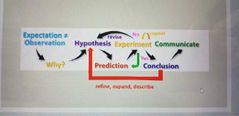
|
|
|
|
What did Avery, McLeod, and McCarthy discover? How? |
That DNA was the transforming principle. They systematically destroyed all major components of a cell to see which would affect the ability of R strain S. pneumoniae to transform into virulent S strain. Ability to transform stopped with destruction of DNA. |
|
|
|
What is responsible for the fact that DNA has polarity/directionality/orientation? |
The sugars in the DNA backbone are asymmetric. A ssDNA has polarity for this reason. The dsDNA evens out and has no overall polarity. It is, however, negatively charged. |
|
|
|
What type of bond holds the nitrogenous bases to the deoxyribose sugar? Which carbon are they attached to? |
N-glycosidic bonds. And the 1' Carbon |
|
|
|
What is DNA packaged into in eukaryotes? Prokaryotes? |
Chromatin and nucleoid respectively. |
|
|
|
What are the five levels of DNA packaging in eukaryotic cells? |
1. Regular double stranded DNA 2. Wrapping DNA twice around core nucleosome (10nm filament/ beads on a string) 3. Coiling nucleosomes together into the 30nm filament 4. Attaching 30nm filament to protein scaffold in long loops. Interphase chromatin (except for constitutive heterochromatin) 5a. Constitutive heterochromatin 5b. Mitotic chromatin |
|
|
|
What is a core nucleosome? Also known as the 10nm filament or beads on a string structure. |
A protein octamer with DNA wrapped around it. The octamer is made up of two H2A/H2B dimers and a tetramer of 2 H3/H4 complexes. There are stands of DNA between nucleosome cores. |
|
|
|
What causes the DNA to wrap around the nucleosome? |
Histones have positively charged grooves (Mainly argenine based). Because the DNA sugar-PO4 backbone is negatively charged, the electrostatic interaction holds the DNA to the histones of the nucleosome. |
|
|
|
What is the H1 histone's function? |
It helps further coil the 10nm filament by binding to each core nucleosome, forming the 30nm filament (aka: the 3rd level of DNA packaging) |
|
|
|
What is Transmission electron microscopy (TEM) used for? In general, how does it work? |
It is a microscopy technique in which a beam of electrons is transmitted through an ultra-thin specimen to form an image. The intensity of the beam transmitted through any given spot inversely reflects how dense the material in that spot is. So if more of the beam is deflected, the spot is more dense. Because of this, the images we look at are the negatives. Otherwise we'd see the dense spots as very light. |
|
|

What is this an image of, and what microscopy technique was used? |
DNA packaged at level 4 (interphase chromatin), the 30nm filament attached to a protein scaffold. This is the basic form of most chromatin (euchromatin) during interphase. This TEM image shows the scaffold with the histones removed so the loops are visible. |
|
|
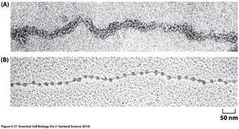
What is this an image of, and what type of microscopy was used to create this image? |
The top is an image of the 3rd level of DNA packaging, the 30nm filament. The bottom is an image of the 2nd level of DNA packaging, the 10nm filament/beads on a string |
|
|
|
How do the level 4 DNA loops form? |

The DNA sequence 30nm filament has scaffold attachment regions (SARs) every 25,000 to 200,000 bp. MARs proteins link the SARs to the scaffold, causing loops to form. |
|
|
|
Describe level 5a of DNA packaging? |
It involves heterochromatin, which is fully condensed throughout the cell cycle, including during interphase. Basically, 5A is the condensed sections of the chromosome. |
|
|

What is this an image of, and what type of microscopy is being used? |
It is a light microscopy image of a polytene mitotic chromosome (a giant chromosome composed of many copies of the genetic material). The darker regions are heterochromatin, and the lighter areas are euchromatin. |
|
|

What is this an image of, and what type of microscopy is being used |
It is a Transmission electron microscope image (TEM) of a nucleus showing lightly staining euchromatin and darkly staining heterochromatin. |
|
|
|
Describe level 5b of DNA packaging. |
This occurs when the chromatin loops condense into short blobs during mitosis. Essentially the fully condensed chromosomes we usually see depicted. Euchromatin becomes as densely packed as heterochromatin. 5b is basically mitotic chromatin. |
|
|

What is this an image of, and what type of microscopy is being used? |
Level 5b DNA packaging, which occurs during mitosis. Scanning electron microscope. |
|
|
|
What is scanning electron microscopy, and how is it done in general? |
A type of microscopy that produces images of a sample by scanning the surface with a focused beam of electrons. The electrons interact with the atoms in the sample, producing various signals that contain information about the surface topography and composition of the sample. Signal depends on 3D shape of sample. Backscattered and secondary electrons are measured. |
|
|

What are these? (See hint for second image) |
Scanning electron microscope (SEM) images of connections between diatoms and a hydrothermal worm. |
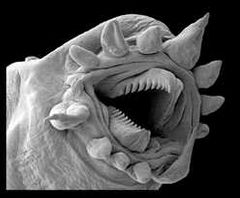
|
|
|
How are we able to see all the levels of DNA packaging? |
All answers have TEM images on the PowerPoint 1. Pure DNA: remove all protein 2. 10nm filament/beads on a string: strong extraction using detergent and low salt to remove H1 histones and leave core nucleosome 3. 30nm filament: moderate extraction using detergent and hi salt, which removes all but H1 and core nucleosomes 4. Protein scaffold: alternative extraction using dextran sulfate, polysaccharide to remove histones but leave scaffold. 5. Interphase & mitosis chromatin: very mild extraction to release chromosomes from cell with most protein still associated. |
|
|
|
What is the swi/snf remodeling complex an example of? |
How chromatin remodeling regulates nucleosome free regions at level 2 packaging. Affects spacing, either allowing more of the DNA to be seen and transcribed, or less by helping to move the nucleosome core. |
|
|
|
What are condensins? |
They bind to the scaffold at the bases of a DNA loops and pull them in until they are more like knobs. This occurs during mitosis when the 5b packaging level is forming. Active = knobs/mitosis Inactive = interphase |
|
|
|
What are histone tails, and what is histone modification? |
N-terminal tails that project from the nucleosome core.
Chemical modifications if these tails changes affinity of nucleosomes for other proteins, which leads to a change in shape and altered access to the DNA wrapped around the core particle. Examples include methylation and acetylation. |
|
|
|
What is Methylation of DNA? |
Occurs particularly in CG rich regions. Causes changes in chromatin structure inhibiting expression of genes in euchromatin. |
|
|
|
What are some mechanisms and enzymes that change chromatin structure? Five listed here with examples. |
1. Histone remodeling: e.g swi/snf complex 2. Histone modifying enzymes: e.g. HMT, HDAC 3. DNA methylation: e.g. DNA methyltransferases 4. Regulate euchromatin loop structure: e.g. condensins 5. Proteins that package heterochromatin: e.g. HP1 |
|
|
|
What are 3 purposes for changing chromatin structure? |
1. Condensation of chromosomes during mitosis 2. Relatively subtle changes in structure to allow transcription, replication, and repair 3. To create the 2 types of heterochromatin: facultative and constitutive |
|
|
|
What is constitutive heterochromatin? Facultative? |
1. Regions that are always heterochromatin such as centromeres and telomeres 2. Regions that switch between euchromatin and heterochromatin. Ex: inactivated X chromosomes (barr bodies) in females. |
|
|
|
True or false: only one level of DNA packaging structure can be modified at a time. |
False. All levels can be modified regardless of other levels being modified. |
|
|
|
True or false: all eukaryotic cells have nuclei while bacteria and archaea don't |
True |
|
|
|
What is the primary function of the nucleus? |
To sequester and organize DNA in its own compartment |
|
|
|
What is the geography of the interphase nucleus? |
1. Nuclear envelope (both inner and outer 2. Nuclear lamin (provide structural function and transcriptional regulation) 3. Nucleolus: where rRNA is transcribed and ribosome subunits are assembled. 4. Nuclear pores DNA is organized within the nucleus. Each chromosome has its own particular place in the nucleus so the strands dont become tangled. |
|
|
|
What is FISH? |
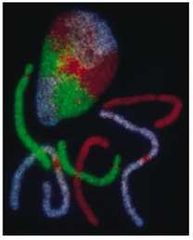
Fluorescent in situ hybridization Uses a fluorescent probe to hybridize to a specified section of DNA, allowing us to see things like what interphase chromatin looks like (chromosome painting). Denature DNA, add probe, anneal |
|
|
|
What was the Meselson-Stahl Experiment? What would the DNA strands look like after three rounds of replication? After four? |
An experiment to see how DNA was copied (conservative, semi-conservative, or dispersive). Centrifuged N¹⁴ DNA and N¹⁵ DNA (which is heavier) separately to see where the DNA would band in the test tube. Then took N¹⁵ DNA and put it in N¹⁴ medium to replicate. After one division, all DNA had one parental and one daughter strand. Thus semiconservative. 2. Divisions = 50/50 N¹⁴ and N¹⁴/¹⁵. 3. Divisions = 6 N¹⁴ and 2 hybrids. 4. Divisions = 14 N¹⁴ and 2 hybrids This is because they are in the N¹⁴ medium, so no new N¹⁵ strands will form, and each strand makes a copy. |
|
|
|
How do you replicate DNA in vitro generally? |
1. Denature DNA leaving single strands 2. Strands each act as a template 3. Add DNA polymerase and dNTPs 4. Allow replication |
|
|
|
How does in vivo replication differ from in vitro? |
In vivo: 1. A very long strand of dsDNA must be replicated 2. ss/dsDNA junction with a free 3' end rarely occurs naturally 3. Both strands must be replicated 4. Replication must have systems in place to prevent errors (high fidelity) 5. Must replicate ends of chromosomes (both leading and lagging strands) |
|
|
|
DNA replication initiates at different ______ and different _______ in the nucleus |
Times and sites |
|
|
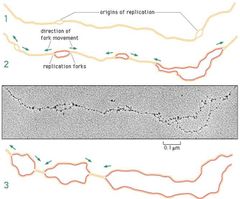
What is this an image of? |
A transmission electron microscope image of DNA replication bubbles |
|
|
|
Where does replication begin? How many places does it begin in prokaryotes? Eukaryotes? |
Replication origin/origin of replication. Prokaryotes have one with a very specific sequence. Eukaryotes have many throughout the genome and are less specific. |
|
|
|
What are the 5 steps of E. coli replication? |
1. DnaA protein binds to DnaA box sequence at origin of replication. This causes the region to wrap around the DnaA proteins, which splits apart the A-T rich region upstream. 2. Helicase breaks hydrogen bonds between strands, and single stranded binding proteins attach to split strands to prevent DNA from reforming. 3. DNA primase binds to the ss/ds junction and lays down a 10nt RNA primer to initiate the replication forks at either side. 4. The sliding clamp/beta clamp encircles strand to hold polymerase and other enzymes to the DNA 5a. Polymerase begins synthesizing new strand in a 5' to 3' direction (moves 3' to 5'). 5b. Topoisomerase/gyrase knicks backbone to relieve super coiling, then reconnects strands (ligase?) |
|

